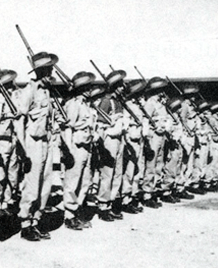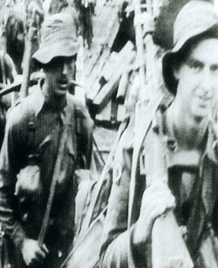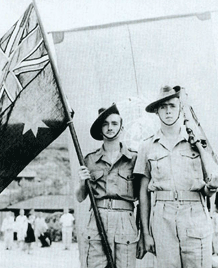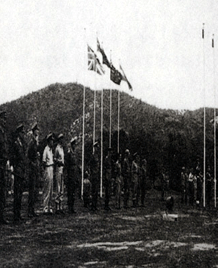 Australia
Australia
List for UN Allies
Background of Participation
As the UN Security Council had adopted the resolution to provide South Korea with military assistance on June 28, 1950, Australia decided to dispatch 2 war vessels and 1 air squadron to South Korea. After the UN Secretary General had asked for the dispatch of ground forces on July 13th, Australia offered to send 1 brigade size force composed of volunteers who had participated in World War II. But as soldiers were urgently needed, the Australian government decided to dispatch the newly organized 3rd Battalion. With the apition of the 76th Infantry Battalion, which was on duty as the occupation forces in Japan. Also, part of military forces stationed at home in Australia. With this decision, the 3rd Battalion, which had been trained in Japan, arrived in Pusan on September 27th.
Activity of the Army
The 3rd Battalion led by Lieut. Colonel C. H. Green, commander of the battalion, moved to Seongju, Kyonsangbuk-do. It became attached to the 27th Brigade of the UK. On October 21st, the 3rd Battalion rescued the US 187th Airborne Regiment which had been dropped on Sukchon and had become surrounded by North Korean forces. In this battle, the 3rd Battalion killed 150 North Korean soldiers and captured 239. On October 30th, Lieut. Colonel Green was killed by a mortar shell.
On April 22, 1951, when Chinese troops, which had launched the Spring offensive, tried to advance to Kapyong, the Battalion repelled them through a series of offensive and defensive battles at Hill 504 of Jugdun-ri. The 3rd Battalion suffered losses of 31 soldiers killed 58 injured, and 3 missing in this bloody battle. The 3rd Battalion was awarded a citation by the US President for its merits of deterring Chinese forces. On July 28, 1951, the 3rd Battalion was included in the newly created 1st Division of the British Commonwealth. It moved to the Imjin River. On October 3rd, the 3rd Battalion attacked Mt. Maryang, a strong post of Chinese forces, under Operation Commando. However the offensive was not effective because of the rugged surface of the land and the strong resistance of the enemy. Five days later the Battalion resumed the attack and succeeded in taking the mountain. With the arrival of the 1st Battalion at Pusan in April 1952, Australia fought with two infantry battalions in the Korean War. On December 10th, the 1st and 3rd Battalions, for the first time since their participation, deployed side by side near Mt. Kowang, and carried out an operation to capture the enemy.
On January 31, 1953, the two battalions moved from the Jamestown line to Dongduchon, and took two months of rest. On March 21st, the 2nd Battalion arrived at Dongduchon to replace the 1st Battalion. The 2nd Battalion was deployed in the area of Hill Hook, the west of Samichon at the end of June. On the night of June 24th and on the morning of June 25th, Chinese Communist forces (CCF) attacked the Hill Hook area. The 2nd Battalion repelled them, being helped by close air support. It was the last battle for the Australian military.
Activity of the Navy
The frigate Shoalhaven and the destroyer Bataan were attached to the US Far Eastern Navy Forces. It carried out the mission of protecting transport ships between Japan and Pusan. During the Inchon landing operation, two destroyers (the Warramunga, and the Bataan) performed their duties of protecting aircraft carriers. as well as that of naval firing and sea patrol around Kunsan and Inchon.
As the UN forces began to retreat from Pyongyang in early December, the two destroyers from Australia were attached to the British Task Force Unit. They protected the retreat of wounded soldiers and refugees at Jinnampo. The Warramunga once struck a rock when entering the Jinnampo port because of the swallow water.
At the end of August 1951, the light aircraft-carrier Sydney, which was loaded with 3 air battalions, the destroyer Anzac, and the frigate Murchison participated in the war, maximizing the war capability of the Australian Navy. From early 1952, only the two destroyers were in operation while other vessels returned home. The Warramunga and the Bataan carried out missions of coastal blockade, coastal shelling, and strategical defense of islands in the East sea and in the Yellow sea, respectively.
Activity of the Air Force
The 77th Squadron of the Royal Australian Air Force (RAAF) was thrown into close air support, beginning with the covering of B-26 bombers on July 1, 1950. The commander of the squadron, Colonel Spencer, died on September 9th, while his unit was bombing Angang where a large enemy force was gathered.
The RAAF squadron, which changed its aircraft from the Mustang (F-51) to British Meter-8 Jets in April 1951, engaged in the first fight with MiGs in the area of the Chongchon River on August 29th. 12 Meter Jets carried out a large scale of air battle with 15 MiGs in the same area the miple of September. From the end of 1951, as the MiGs frequently appeared in the sky of Seoul, the squadron was assigned to defense of the capital region. However, in the latter half of the year, the British Air Force supplied pilots for the Australian squadron, owing to increasing losses of pilots by enemy anti-aircraft fire.
In 1953, the squadrons mission of bombing continued. At the end of June, two Meter Jets were severely damaged by enemy anti-aircraft fire while they were patrolling north of the Chongchon River. But the pilots made an emergency landing without giving up, proving their responsibility and courage. This was the last operation of the 77th Squadron. Australia dispatched 17,000 soldiers to Korea. Among them, 306 were killed, and 1,216 wounded. After the armistice, the Air Force withdrew from Korea in October 1953, the Navy in February 1954, and the Army in March 1956.




